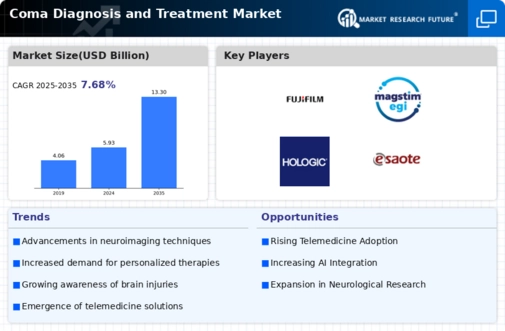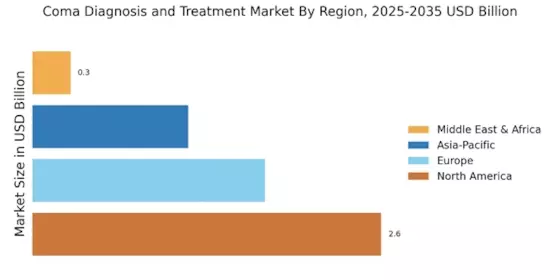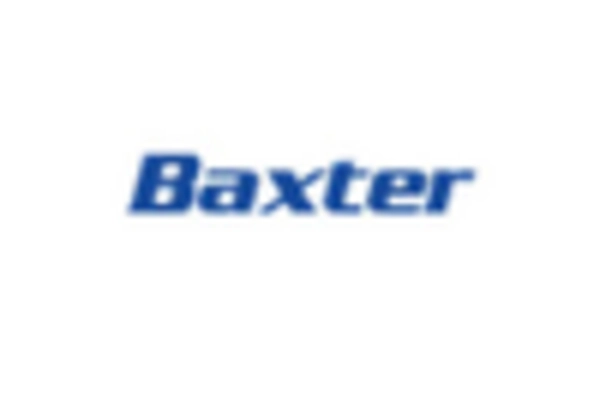Emerging Research and Clinical Trials
Emerging research and clinical trials focused on coma treatment methodologies are likely to play a significant role in shaping the Coma Diagnosis and Treatment Market. Ongoing studies aim to explore novel therapeutic approaches and interventions that could improve recovery rates for coma patients. The results of these trials may lead to the introduction of new treatment protocols and diagnostic criteria, thereby enhancing the overall effectiveness of care. As research institutions and pharmaceutical companies invest in this area, the potential for groundbreaking discoveries increases. This influx of innovative treatment options is expected to attract attention from healthcare providers, ultimately driving demand within the market. The continuous evolution of research in coma management indicates a promising future for the industry.
Rising Incidence of Neurological Disorders
The increasing prevalence of neurological disorders, such as traumatic brain injuries and strokes, appears to be a primary driver for the Coma Diagnosis and Treatment Market. According to recent statistics, neurological disorders account for a substantial percentage of global morbidity and mortality. This trend necessitates advanced diagnostic tools and treatment protocols, thereby propelling market growth. As healthcare systems strive to improve patient outcomes, the demand for effective coma diagnosis and treatment solutions is likely to rise. Furthermore, the aging population, which is more susceptible to such conditions, contributes to the growing need for specialized care in the coma diagnosis and treatment sector. Consequently, healthcare providers are investing in innovative technologies and methodologies to address these challenges, indicating a robust market potential.
Technological Innovations in Diagnostic Tools
Technological advancements in diagnostic tools are significantly influencing the Coma Diagnosis and Treatment Market. Innovations such as advanced imaging techniques, including MRI and CT scans, have enhanced the accuracy of coma diagnosis. These technologies allow for better visualization of brain activity and structural abnormalities, which are crucial for determining the appropriate treatment. The market for diagnostic imaging is projected to grow, driven by the increasing demand for precise and timely diagnosis. Moreover, the integration of artificial intelligence in diagnostic processes is expected to further streamline operations and improve patient outcomes. As healthcare providers adopt these cutting-edge technologies, the overall efficiency and effectiveness of coma treatment protocols are likely to improve, thereby fostering market expansion.
Increased Investment in Healthcare Infrastructure
The surge in investment in healthcare infrastructure is a pivotal factor driving the Coma Diagnosis and Treatment Market. Governments and private entities are allocating substantial resources to enhance healthcare facilities, particularly in emergency and critical care settings. This investment is crucial for the development of specialized units equipped to handle coma cases effectively. Enhanced infrastructure facilitates the acquisition of advanced diagnostic and treatment technologies, which are essential for managing complex coma cases. As healthcare systems evolve, the focus on improving patient care standards is likely to lead to an increase in the demand for coma diagnosis and treatment services. Consequently, this trend is expected to bolster market growth as healthcare providers strive to meet the rising expectations of patient care.
Growing Awareness and Education on Coma Management
There is a noticeable increase in awareness and education regarding coma management, which serves as a significant driver for the Coma Diagnosis and Treatment Market. Healthcare professionals are increasingly being trained in the latest coma management protocols, leading to improved patient care. Educational initiatives aimed at both medical staff and the general public are crucial in recognizing the signs of coma and understanding the importance of timely intervention. This heightened awareness is likely to result in earlier diagnosis and treatment, which can significantly enhance recovery outcomes. Furthermore, as more healthcare institutions implement comprehensive training programs, the demand for effective coma diagnosis and treatment solutions is expected to rise, thereby positively impacting market growth.


















Leave a Comment